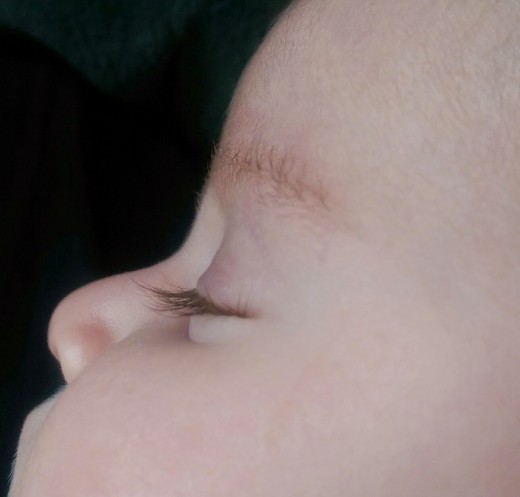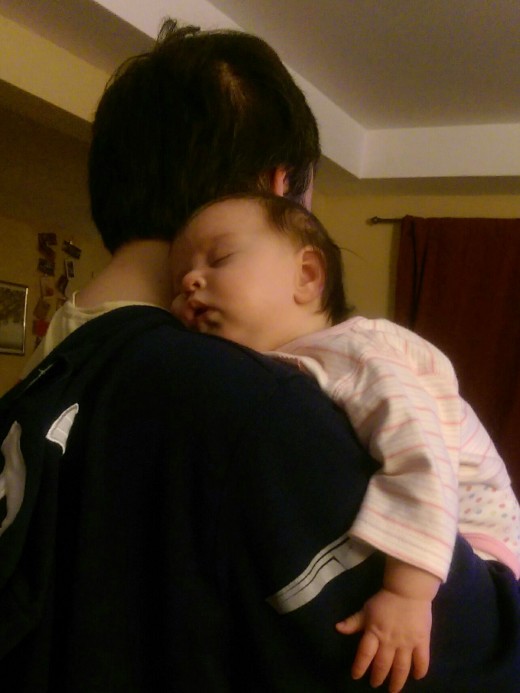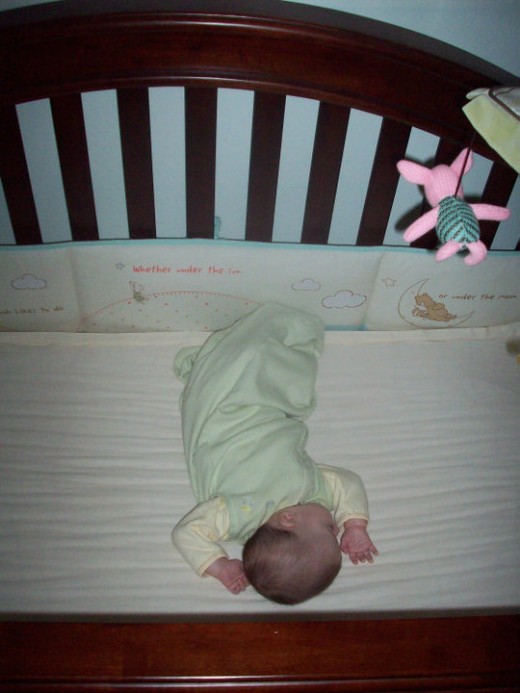Sleep Training Your Infant - Without Crying It Out
The Conundrum
From the time your baby comes home with you, the question in your mind, as well as the one your friends and family constantly ask you, is: how is the baby sleeping? Are they sleeping through the night yet?
This question alone can give you stress - you're tired, and you can't sleep when the baby is awake, and all you want to do is SLEEP! Fretting about the lack of sleep creates a horrible cycle - when you are stressed, the baby is stressed, and neither of you are resting. It's time to break the cycle!

Guiding Principles
This method was based on the following principles. These principles can be applied towards any strategy for child rearing. Most are based on Tracy Hogg's book, Secrets of the Baby Whisperer.
- Babies are people, and deserve respect and consideration for their needs and desires.
- Parents are in charge, and their needs and desires should be met, as well.
- Babies, just like people, like and want to sleep.
- Babies don't need to literally sleep through the night, they just need to learn how to fall back asleep independently if they do wake up. Adults do the same thing several times a night, but they do it so quickly they usually aren't even aware of the disruption.
- Each baby is different, and their differences in temperament, personality, and mood should be respected.
- Babies don't necessarily need schedules, but most will respond to a routine to help them understand and predict "what comes next." The routine should meet both the parents' and baby's needs.
- Infants provide cues as to their current needs, and parents should listen and observe these cues in order to communicate effectively with their baby.
- Generally follow doctor's recommendations, especially those provided by the American Academy of Pediatrics.
- When a baby's needs are met, they should be put down to give them "the gift of independence."
Overview of this Sleep Training Method
- Learn to calm yourself.
- Learn your baby's cues.
- Meet all of your infant's needs, including eating, clean diaper, gas, etc.
- Teach your infant the difference between day and night (and that we sleep at night).
- Encourage your baby to sleep independently.
Babies don't need to literally sleep through the night, they just need to learn how to fall back asleep independently if they do wake up. Adults do the same thing several times a night, but they do it so quickly they usually aren't even aware of the disruption.
Get Zen!
We are all entitled to occasionally flip out, especially when we are sleep deprived. However, continually high stress levels are bad for you and for your baby. Have you ever noticed how when someone is nervous holding a baby, the baby tends to be fussier? That's because babies can sense our moods and feed off of our energy. And this isn't some new-age mumbo jumbo, either. Clinical studies have shown that we affect our babies just by being in physical contact, by making eye contact, or by the sounds of our voices. Our heart rate, mood, and the pheromones we secrete are all at play, and how we interact with our child actually impacts their brain development.
"Focus on centering yourself, and your baby will respond to the energy that you are emanating."
I had a yoga instructor who would say this often during a Mommy & Me class, whenever she saw moms frantically trying to calm their babies. Shortly thereafter, an eerie quiet would take over the room as all the moms found their center and the babies calmed in response.
Tips for keeping calm:
- Take slow, deep breaths, in through your nose, out through the mouth.
- Close your eyes and sit down (even if holding the baby).
- Slowly count to 10 or sing the alphabet.
- Sing your favorite song, even if it isn't baby friendly.
- Stretch your muscles. Your shoulders and neck get particularly tight with high stress levels.
- Walk away from a fussy baby if you feel yourself getting more agitated. Just put the baby somewhere safe first (like a crib, bassinet, or bouncy seat).
- If you feel the need for a longer break, take a shower, even if that means continuing to leave a fussy baby. The warm water will relax your muscles and the sound of the water will help you relax.
- If someone else is around, have them care for your baby while you relax.
- Laughter is a great stress reliever. Take silly selfies, watch a bad TV show, dress your baby in ridiculous outfits, whatever you can come up with to help you keep things light.
- Smile!
Once you have calmed yourself, if your baby is fussing or just too awake, either embrace them or, if they are laying down, place one hand gently on them. Continue to breathe slowly and deeply, and try to keep your heart rate slow and steady. This will help calm them as well.


Reading Cues: "He's Trying to Tell Me Something, I Know It!"
Okay you're baby is crying or fussing, what do you do? First, don't do anything. Stop and observe them so you can figure out what they need. If you just start throwing food and blankets and toys at them all the time they will get annoyed. Each baby is different and may do different things to try to express themselves, but here are some guidelines to help you decode their cues and body language.
Note: when I refer to a "cry" in this guide, it's really more of whatever unhappy sound your baby is making. Call it fussing, whining, crying, whatever - it's their way of communicating with their voice.
- I'm hungry. Newborns will turn their heads from side to side with their mouth open, looking for something to latch onto. Older babies will change their tone and act kind of excited when they get within range of a bottle or breast. If they are crying, it will be an assertive, sometimes almost grunting type of cry. The faster they turn their head to a nearby nipple, the hungrier they probably are.
- I'm uncomfortable. This cry will sound annoyed. It could be that they are hot or that they have a soiled diaper, or even that their clothes are irritating their skin. Or they could have mild gas. They may try to rub whatever feels uncomfortable or arch their back to avoid sitting on their diaper, or wriggle around to try to get out gas. If their skin is flushed and their head or back is sweaty, they are too hot. Check the diaper for a lot of pee or any poop. Pat their back - if it sounds hollow, they probably need to burp. Check their abdomen - is it hard? If so, they probably have gas or need to poop. If nothing seems obvious, check their clothes for irritating tags or velcro rubbing their skin. The most frustrating scenario here is if they're crying because they're uncomfortable because they have a stuffed up nose - ah the irony!
- I feel pain. The first time you hear this will likely be when a doctor is taking blood or giving them a vaccination. The cry is usually high pitched and piercing - an alarm saying "imminent danger!!" Evolution has taught babies to freak you out when they feel pain. This could be severe gas, or maybe something has pricked them (maybe even a bug). Alternatively, if they are sick, you may hear this, especially when they cough, because their throat hurts.
- I'm tired. This cry sounds sad, because they don't have the energy to cry properly. Usually their eyes are closed or drooping and they may rub their eyes as well. If you're holding them, they will probably rest their head on your shoulder or turn their face inwards to try to block out light and other stimulating parts of the environment.
- I'm overtired/overstimulated. This is one of the trickier ones. Sometimes they didn't give any of the normal "tired" signals, other times you just missed them. In any case, this is one of the signals most often misunderstood, especially by well-intentioned relatives. Put the rattle down, Grandma, and step away from the baby. For lack of a better word, your baby will sound like it's freaking out - crazed, if you will. Has it been awhile since your baby slept? Are they flipping out more when you show them a toy? Are they turning away or avoiding eye contact? Is there a lot going on in the room that you are in - loud noises, bright lights, lots of people? Your baby may need to get taken out of the environment and into somewhere quiet and dark to help calm down properly.
- I'm cold. Every time I've seen a cold baby, I've noticed this is the most distinguishable sound they make. They sound weak. It is a quiet, mild cry - which almost makes it more alarming, because it makes you think that if you don't do something soon, they may fade away altogether. If you are cold and wearing the same amount of clothes as they are, then they're cold, too. Chuck on more clothes and more blankets and pump up the thermostat.
- I'm scared. You generally won't hear this until they are at least a couple months old. This will be similar to the "I'm in pain" cry in that it will be piercing and alarm-sounding, but will generally sound less angry and more sad. It will likely be triggered by a loud noise or an abrupt enough movement that will trigger their Moro reflex because they think they are falling. As they get older, you will hear this when you leave them with another caretaker or when they are in the dark.
- I'm lonely or bored. Usually this is similar to the uncomfortable cry - because in both cases, the need is not as urgent. This probably sounds the whiniest, and usually it's not constant - they will moan on and off. Simply smiling at them may make them stop crying. They may want a change in scenery or position or they may want some interaction. This will generally never happen before they are a few months old - you are more likely to over-stimulate than ever bore them when they are a newborn.
To complicate matters, babies don't always have just one need to meet at a time. Sometimes they are hungry, but they won't eat because they are gassy. Sometimes they are tired but they can't go to sleep because they are hungry. Sometimes they have to poop so they can't eat. Just remember to take it as it comes and breathe!
Eating and Sleeping
How well your baby sleeps is directly tied to how they eat. One common misnomer is that babies have tiny stomachs and digest their breast milk or formula too easily and that's why they can't stay full through the night. However, adults don't "stay full" from dinner all the way until breakfast - we've just taught our bodies to be accustomed to not eating during that time, while we sleep.
The real secret here is that babies need to take in enough breast milk or formula during the day so that they meet their daily quota before sleeping. For breast fed babies, this means roughly 24 ounces per day. If you or your partner is exclusively breastfeeding your baby, and you're not sure if they are getting enough milk each day, try expressing some milk and see how much you get - a yield, if you will. If you only get one or two ounces - that's okay! But realize that is why your baby is nursing 12 or more times a day. There is no way they can get all the milk they need in 14-16 hours, so they wake up to get the rest. As you or your partner continue to increase production, this should get better. Alternatively, you can consider supplementing with formula.
At some point in the day, your baby will likely do what's called cluster feeding. If you are breastfeeding, this means they nurse every 20-45 minutes for a few hours straight just before passing out. If you are bottle feeding, it means they will take a large bottle or multiple bottles in short succession before they go to sleep. Lucky parents have babies who are doing this between 5 and 9 pm, but sometimes babies do this in the wee hours of the morning or other times that frazzle the parents. This is part of their effort to get in their necessary nutrition so they can sleep. You can encourage this behavior to be at the best times by doing the following:
- teaching them the difference between day and night (see below for details)
- offering the bottle or breast often during the "ideal" cluster feeding time (a few hours before your ideal bedtime)

Phase 1: Newborn - or, "Anything Goes"
In the first month or two, unless you are part of the 0.0005% of the population with a baby that sleeps through the night immediately, you will be exhausted. If you or your partner are trying to exclusively breastfeed, it will seem relentless as your baby tries to make the supply match its seemingly insatiable demand. If you bottle feed, you will deal with bottle experimentation, formula experimentation, all in an effort to make your baby more satisfied and agreeable.
The rule here is - don't sweat it. Anything you do here is forgivable. If your baby will only sleep in an infant swing or bouncy seat, so be it. If you end up co-sleeping, fine (just take safety precautions). Shower when you must and nap when you have the time. Eat one handed. Do whatever it takes to get by and don't feel pressured to do things such as:
Pitfalls to avoid during phase 1
- trying to establish a daily schedule. Don't bother with one until your baby's cues lead you to it. They will eventually help you establish a routine, but if you try to force one on them, the both of you will end up frustrated and just as tired.
- give a daily bath to calm the baby down for sleep. Most newborns fall asleep like twenty times a day - the problem is STAYING ASLEEP! Baths are so much work and newborns only need a bath once a week, if even that.
- not letting them sleep during the day (because "their days and nights are mixed up"). First of all, they need around 17 hours of sleep per day. Secondly, sleep begets sleep. If they sleep during the day, take at least some of that time for you to relax and/or nap. Do not wake a sleeping baby unless they are sleeping for more than 3 hours straight during the day - and even then, you may not want to bother trying to wake them up unless you think they aren't eating enough during the day.
- not letting them sleep during the night (because they need to eat every 4 hours). Unless they were a preemie or otherwise weren't gaining enough weight and so your pediatrician had a specific concern, let them sleep! Feel free to check on them, but there is no need to try to feed them if you know they are eating enough.
- Changing their clothes in the morning and night. They can wear pajamas all day. Outfits that are comfy enough can double as pajamas. Change them if they get spit up or poop all over themselves. The rest will take care of itself. They will survive wearing the same clothes for 48 hours.
- feeling pressured to breastfeed all the time. Pumping before handing the baby off to someone else so you can nap will be both relieving and empowering. And nobody ever said that they were a failure in life because their parents decided to give them some formula. If your long term goal is to exclusively breastfeed, make sure you pump for at least 30 minutes whenever you give your baby a bottle to establish your supply.
- keeping a clean house. Tidy up if you find it therapeutic or if the mess is stressing you out, but otherwise the mess will be there for you after you've gotten sleep.
Things to do during phase 1
- pick a time you deem ideal for your infant's bedtime. Every night turn off all the lights and draw the curtains (if the sun is still up) at that time. Lower the volume on any TV or radio you may have on. Generally, make the whole environment less stimulating. Keep your house this way until the ideal wake-up time. For example, 8 pm bedtime and 7 am wake-up time. Leave on some nightlights so you can see while caring for your baby.
- try to engage your baby less during this time, especially between a core 7-8 hours during your ideal sleep time. For example, between 10 pm and 5 am, no tickling or cooing or playing with your baby during feedings and diaper changes - this is business only, folks!
- read your baby's cues and meet their needs as appropriate, no matter what the time
- give them a pacifier if they appear to want to suckle but you think they aren't or shouldn't be hungry, especially during the nighttime hours. Pacifier use reduces risk of SIDS and the American Academy of Pediatrics actually recommends it in the first six months.
- when in doubt, burp your baby. Babies are gassy. They won't calmly lie down if they need to burp.
- consider swaddling your baby. One misnomer is that all babies should be swaddled for the first several months, but every baby is different. Some like to be swaddled and some do not - respect their preferences and they will sleep better. If they keep busting out of it, they may need to wiggle a lot in their sleep - let them.
- put your baby to sleep on their back. The Back is Best campaign attributed to a 50% decline in SIDS in the United States.
- put your baby down once it is asleep. Even though everything you do here is forgivable, if you never put them down you will have some habits to break later on and it will be painful for everyone. Trust me, they won't mind. They might want the space.

Phase 2: "Is That a Light at the End of the Tunnel, or a Freight Train?"
Usually between 6 and 10 weeks, if you've been following your baby's cues and also teaching them between day and night, their circadian rhythm is likely established. They will be sleeping for longer stretches at night (2-4 hours at a time) and waking up 1-3 times a night for feedings or pooping, but then going back to sleep relatively quickly. If that's the case, congratulations and welcome to Phase Two.
Pitfalls To Avoid During Phase 2
- getting overtired - babies still only stay awake for 1-2 hours at a time and will take 3-5 naps a day in addition to whatever sleep they get at night. As they get older, it gets more difficult to calm them down when they are overstimulated.
- feeding your baby whenever they wake up at night so they go back to sleep faster. Read their cues. Even then, assume they aren't hungry until all other possibilities are eliminated. Remember that you are playing this for the long haul - a baby and then a child who can go to sleep independently.
- creating an arduous bedtime routine. Bedtime routines can be helpful, but the examples provided by so-called experts are often ridiculous and counter-productive for this age. The bedtime routine at this age should take no longer than 15 minutes, excluding feeding time, otherwise it has the potential to overstimulate your baby at the worst possible time of day. This means you either shouldn't read that 30 page book or you should skip the bath time. Figure out what helps to calm your baby and go with that.
- creating bad habits. Your baby cannot sleep on your lap all the time. They need to get used to sleeping in their own space. At this point I highly suggest discontinuing co-sleeping if you were doing that during phase 1. You can't spoil a baby, but you can teach it to expect certain things that you may not be ready to continue. You and your partner very likely do not want your baby to continue sleeping with you in the months and years to come, so it's best to get them used to sleeping independently now. To quote The Baby Whisperer, "start as you mean to go on."
Things to Do During Phase 2
- re-evaluate sleeping conditions. If your baby is currently sleeping in your room, do you want to continue that, or do you want to move them into the nursery? If you don't do it now, make sure you do it within the next couple of months, or else it will just disrupt your baby's sleep even more.
- be consistent in where you put your baby down. Start to put them in the same place for nighttime each night if you have more than one sleeping location (for example, a bassinet in one room and a crib in another).
- when your baby wakes up in the middle of the night, evaluate their needs based on cues, but go first with soothing and leave feeding as a last resort. This teaches your baby that nighttime is not for eating and that they don't need to eat to fall back asleep.
- if you hear them wake up, but they don't sound particularly upset, give them a moment and see if they put themselves back to sleep. Only go in if they sound agitated and they are working themselves up. Even if they only go back to sleep 5% of the time, they have now learned it is possible and they will start doing it more often.
As time goes on, your baby will generally start waking up less often during the night, and will have occasional 7 to 10 hours straight at a time.

Phase 3: "Almost There... Stay On Target..."
If your baby sleeps for a straight 7 hours or more most nights, congratulations, you are in phase 3! Most babies hit this by around 3 months, if not earlier (some as early as 6 weeks), if parents have been following this guide so far. This is now considered "sleeping through the night" according to medical experts. You can rest assured that your baby does not need to eat during the night in order to stay healthy and to continuing growing at an appropriate rate.
The issue some parents have is that it may not feel like their baby is sleeping through the night - they may be sleeping from 8 pm to 3 am, for example. But 10 pm to 5 am doesn't sound as bad, right? Both are 7 hour stretches.
If your baby is waking up too early for your liking, do the following:
- even if they are only half awake, continue to offer milk or formula until they are totally asleep at bedtime.
- burp them thoroughly before putting them down to sleep, even if they have already dozed off.
- when they wake up in the wee hours of the morning, try soothing with a hand on their belly, putting on their mobile, or giving them a pacifier (or whatever other soothing tricks you have learned work for your baby). They may wake up 20 minutes later, but if you keep at it, they will start sleeping longer stretches without squawking for you.
- if you hear them wake up, but they don't sound particularly upset, give them a moment and see if they put themselves back to sleep. Only go in if they sound agitated and they are working themselves up. Even if they only go back to sleep 5% of the time, they have now learned it is possible and they will start doing it more often.
- during the day, try increasing their portions. For example, if you were doing 4 ounce bottles, try 5 ounces. If you are nursing during the day, offer both sides at each feeding.
- evaluate their cues from earlier in the evening - do they need an extra nap before their last feeding? For example, maybe they need to sleep from 6:30 to 7:30, eat, then go down at 8:30, rather than staying up for a few hours and going to sleep at 8 pm.
- continue to encourage cluster feeding
- during daytime naps, put your baby down!
- If they are waking up gassy (farting or burping) - evaluate what and how they are eating. Maybe you need to try a different kind of bottle that takes in less air, or maybe you need to change brand of formula, or if you are nursing, maybe there is something in your diet that you have difficulty digesting.
If your baby is going down to sleep later than your ideal bedtime, do the following:
- make sure you are following all of the "tell them it's nighttime" cues from phase 1
- do their last feeding(s) in their nursery, with the lights off and curtains drawn (but keep a night light on so you can see!)
- during the day, try increasing their portions. For example, if you were doing 4 ounce bottles, try 5 ounces. If you are nursing during the day, offer both sides at each feeding.
- implement a simple bedtime routine, if you haven't already, to help them calm down.
With time, your baby should start sleeping for longer and longer stretches. If there is a hiccup one or two nights, don't fret - it could be a growth spurt or just some random aberration. Keep at it and they will generally sleep more and more consistently.
Sample Bedtime Routines
Age
| Routine
|
|---|---|
up to 2 months/phase 2
| feed, burp, swaddle (optional)
|
3 - 6 months/phase 2 & 3
| put on pajamas, feed, burp, sing a lullaby or read a short book
|
6 - 12 months/ phase 3 and beyond
| put on pajamas, feed, read 1-3 short, calming books or 1 longer book (no more than 10-20 minutes of reading), sing a lullaby
|
Frequent Issues & Questions
- My baby falls asleep during feedings, but then wakes up as soon as I put them down.
I call this "babies playing possum." Try burping them - either they will perk up after burping and eat some more, or the gas they release will allow them to sleep for real. - My baby was in the NICU for a period of time and/or they were premature, and now they wake up every 4 hours like clockwork at night, even months later.
Once your doctor gives you the go-ahead that they have gained sufficient weight, you can move into phase 2 & 3. It may be slower than the average baby, but rest assured that long-term your baby can still become a "good sleeper." - My baby eats every 45 minutes to 1 hour during the day. Then at night they are very fussy and difficult to settle down.
This is likely due to gas and indigestion. Newborns who are only a few weeks old may do this type of eating behavior, and it is completely within the realm of normal. As they get older, however, they are probably overeating. Make sure you are reading their cues correctly during the day. Consider introducing a pacifier if you haven't already. - My baby eats what I think is an appropriate amount and frequency during the day, but at night they are still very fussy.
This is still likely due to gas and indigestion, but between the ages of 2 and 10 weeks this is likely "colic." Don't worry, all that word means in the pediatric world is that your baby has gas and indigestion due to a developing gastrointestinal system. As they grow it will get better. - My baby was sleeping through the night, and then at 4/6/9/12 months they started waking up more frequently.
This is called a "sleep regression" and it happens very often around baby's milestones - learning to roll over, sit up, stand up, talk, etc. It's as if the babies are busy trying to practice their new skills and/or their brains are on overdrive so they're having more trouble winding down. Go back to the methods in phase 2 and 3, but avoid feeding them unless absolutely necessary - there is no way they need it nutritionally, but occasionally babies do get thirsty (especially if humidity in your home is low). Use the "pick up, put down" method if they are sitting or standing in their crib at night and all needs are met - this means you literally just lay them back down while soothing them. Each time you go in, be more brief. Once they hit one years old, offer them a spill-proof sippy cup of water at night whenever you think they might get thirsty. - My baby is sick and is waking up all the time!
All the usual rules go out the window. Feed them whenever you think they need it, cuddle them as often as you'd like, and don't let them fuss by themselves at night - it will just irritate them more. They're miserable enough as it is. They need fluids and if you're nursing you will provide antibodies that may help them get better faster. If they have a lot of mucus, they may only want to sleep upright in a bouncy seat or even on your chest. Once they're better, get right back at all the rules and guidelines - they need the sleep; it helps their immune system. - Why do you discourage co-sleeping?
This type of decision has a long-term effect, so it deserves careful consideration. These are the reasons in most situations, it's a bad idea:
(a) The majority of cases I have seen have been where the mother wants to co-sleep and the father wasn't given much of a choice. The father gets a say in who stays in his bed. For purposes of keeping a healthy marriage, I recommend keeping the master bed isolated from distractions and interruptions so that proper intimacy can take place.
(b) in all parenting advice, my overarching theme, taken from Secrets of the Baby Whisperer, is "start as you mean to go on." This means that anything you do, you need to picture if you're okay doing with your kid as they grow up. If you are co-sleeping with a newborn - when do you plan to cut it off? At 6 months? At 1 year? At 5 years? Does your partner agree with that? What if you have another child and your older one is still co-sleeping with you? If you have definitive answers for all of these things, then go ahead, but many people enter a co-sleeping arrangement with a half-baked notion of attachment parenting, only to determine six months later that they lack an exit strategy, that nobody is sleeping, and that their relationship with their partner is on thin ice.
This all being said, to each his own, and if it honestly works for your family, all the power to you! (Just don't ask me for sleeping advice) - I've been swaddling my baby and now I'm trying to stop but they seem so twitchy - I think their movements are waking them back up.
Buck up. You can't swaddle them when they're 17 years old. At some point they have to learn to deal with flailing limbs. Also, it may actually help them sleep as they wiggle out gas or soothe themselves with their fingers in their mouth. The American Academy of Pediatrics recommends discontinuing swaddling by 3 months to prevent issues in hip development. If your baby begins rolling over, swaddling is a safety hazard as they can get tangled. If you are having trouble eliminating the swaddle, try swaddling less and less tightly over the course of a few nights, or swaddling just the arms or just the legs. This gradual shift may help your baby adapt to the change more easily. - I included reading a book in my bedtime routine but my baby gets really excited instead of calm.
Every baby is different. Your baby is not calmed by books, so don't read books when you want them to get calm. Do not include them in your bedtime routine. Maybe include them in another time of day.
Alternative Sleep Training Methods
Each method of sleep training is based on its own methodology. If you don't agree with the principles this sleep training is based on, then this probably isn't for you. Here are some alternatives:
- Ferber method: this is a graduated extinction method where parents are supposed to ignore children's cries and only check/soothe them at preset intervals of time that gradually increase with each check-in. This is the method most commonly associated with "cry-it-out," although the term is never used in the original book, Solve Your Child's Sleep Problems, by Dr. Richard Ferber. Jodi Mindell, author of Sleeping Through the Night: How Infants, Toddlers, and Their Parents Can Get a Good Night's Sleep, also advocates a variation in this same method.
- Extinction with parental presence: this is a method similar to the Ferber method, except parents remain in the room with the child while they are crying it out.
- Baby wise: this extreme method originates from a philosophy based on a sect of fundamental christianity that discourages following baby's cues and instead assuming that the parent knows what is best and is the sole decision maker to put them on a strict schedule. It i considered the polar opposite to attachment parenting and was outlined in a book, On Becoming Baby Wise, written by Gary Ezzo and Dr. Robert Bucknam.
- attachment parenting: this method, first popularized by Dr. Sears in The Baby Sleep Book, is based on the theory that babies need to be attached to their parents through actual physical contact during the early child rearing years, and that it is best to let the baby lead in choosing when to sleep independently from the parents in order to best nurture their emotional development.



